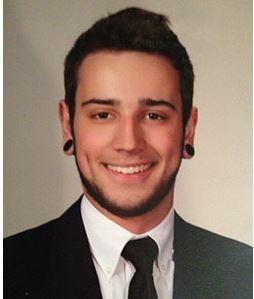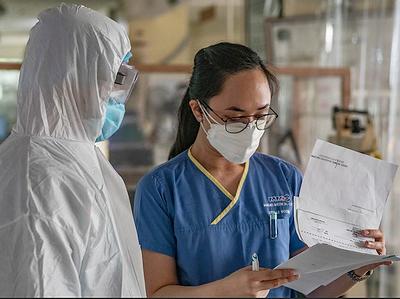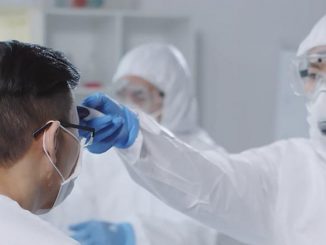
SANTA BARBARA, California, April 23, 2020 (ENS) – As the world races to find vaccines, therapies and cures for the deadly respiratory disease COVID-19, the deep ultraviolet color of rare UV-C light rays may soon be seen cleaning surfaces, as well as air and water, contaminated with the novel coronavirus that causes the disease.
To date worldwide, COVID-19 has infected 2,638,909 people and claimed 184,249 lives, since it emerged in Wuhan, China late last year, according to the latest data from the World Health Organization.
Research to bring highly effective UV-C light-emitting diodes, LEDs, to market quickly is taking place at the University of California Santa Barbara Solid State Lighting & Energy Electronics Center, SSLEEC, and at member companies.
“One major application is in medical situations – the disinfection of personal protective equipment, surfaces, floors, within the HVAC systems, et cetera,” said materials doctoral researcher Christian Zollner, whose work centers on using deep ultraviolet light LED technology for sanitation and purification purposes.
UV-C LEDs have been around for a few years, but they have suffered from what the researchers call poor light-extraction efficiency. Zollner says a small market already exists for UV-C disinfection products in medical contexts.
SSLEEC member company Seoul Semiconductor in early April announced the “world’s first proven coronavirus (COVID-19) sterilization.”
Seoul Semiconductor, the world’s second-largest global LED manufacturer, reported a “99.9 percent sterilization of coronavirus (COVID-19) in 30 seconds” with their ultraviolet LED product. Their technology is being adapted for automotive use, in ultraviolet LED lamps that sterilize the interiors of unoccupied vehicles.

But deep UV-C LED arrays from Bolb, Inc., a U.S.-based manufacturer of high-performance UVB/C solid-state emitters, are already helping to combat the coronavirus epidemic in Wuhan. Emitter arrays release strongly disinfecting UV-C light that kills not only coronavirus germs such as MRSA but also the novel coronavirus.
Since the protective suit also protects against UV-C radiation, there is no danger to people. To make the invisible UV-C radiation visible, the headpiece of the protective equipment is coated with a fluorescent paint that glows as the emitters are activated.
In Wuhan’s newly-built Huoshenshan Hospital, this technology is now being used to decontaminate doctors and nursing staff when they enter or leave the coronavirus isolation ward in their infectious disease protective clothing. To do this, Bolb explains, doctors and nursing staff are irradiated from all sides with highly efficient UV-C light for around 30 seconds. The wavelength changes the RNA of the viruses so that they no longer pose a threat.
Not all ultraviolet (UV) wavelengths are alike. UV-A and UV-B, the types we on Earth receive all the time from the Sun’s rays, have their uses, but the rare type UV-C is the ultraviolet light of choice for purifying air and water and for inactivating microbes.
UV-C light is a short-wavelength, ultraviolet light that breaks apart germ DNA, leaving it unable to function or reproduce. In other words, UV-C light is germicidal; UV-A and UV-B light are not. UV-C rays can be generated only by man-made processes.
“UV-C light in the 260 – 285 nanometer (nm) range most relevant for current disinfection technologies is also harmful to human skin, so, for now, it is mostly used in applications where no one is present at the time of disinfection,” Zollner explained.
The World Health Organization warns against using ultraviolet disinfection lamps to sanitize hands or other areas of the skin. Even brief exposure to UV-C light can cause skin burns and eye damage.
Even before the COVID-19 pandemic gained global momentum, materials scientists at SSLEEC were already at work advancing UV-C LED technology.

This area of the electromagnetic spectrum is a relatively new frontier for solid-state lighting. UV-C light is more commonly generated via mercury vapor lamps and Zollner warns that “many technological advances are needed for the UV LED to reach its potential in terms of efficiency, cost, reliability and lifetime.”
In a letter published in the journal “ACS Photonics,” in January the UC Santa Barbara SSLEEC researchers reported their elegant method for fabricating high-quality deep-ultraviolet UV-C LEDs by depositing a film of the semiconductor alloy aluminum gallium nitride (AlGaN) on a substrate of silicon carbide (SiC) – a departure from the more common sapphire substrate.
According to Zollner, using silicon carbide as a substrate allows for more efficient and cost-effective growth of high-quality UV-C semiconductor material than using sapphire.
“As a general rule of thumb, the more structurally similar the substrate and the film are to each other, the easier it is to achieve high material quality,” he said. “The better the quality, the better the LED’s efficiency and performance.”
“Sapphire is dissimilar structurally, and producing material without flaws and misalignments often requires complicated additional steps. Silicon carbide is not a perfect match, Zollner said, but it enables a high quality without the need for costly, additional methods.
In addition, silicon carbide is much less expensive than the “ideal” aluminum nitride substrate, making it more mass production-friendly, Zollner said.
Other researchers include lead author Burhan SaifAddin, who wrote, “The disinfection industry would greatly benefit from efficient, robust, high-power deep-ultraviolet light-emitting diodes (UV–C LEDs).
He describes the problem the UCSB research group worked to solve, that “the performance of UV–C AlGaN LEDs is limited by poor light-extraction efficiency…”
“This work establishes UV LEDs grown on SiC substrates as a viable architecture to large-area, high-brightness, and high-power UV LEDs,” SaofAddin wrote in the research abstract published in January in “ACS Photonics.”
Portable, fast-acting water disinfection is among the applications the SSLEEC researchers have in mind as they continue to develop their UV-C LED technology. The diodes’ durability, reliability and small form would make them ideal for less developed areas of the world where clean water is urgently needed.
In addition to UV-C for water sanitation purposes, UV-C light could be integrated into systems that turn on when no one is present, Zollner said.
“This would provide a low-cost, chemical-free and convenient way to sanitize public, retail, personal and medical spaces,” he advised.
For now Zollner and his colleagues are waiting out the pandemic as UC Santa Barbara research has dwindled to minimize person-to-person contact.
“Our next steps, once research activities resume at UCSB,” said Zollner, “is to continue our work on improving our AlGaN/SiC platform to hopefully produce the world’s most efficient UV-C light emitters.”
Among the contributors to this research is Shuji Nakamura, one of the three recipients of the 2014 Nobel Prize for Physics for the invention of efficient blue light-emitting diodes.
Steven DenBaars, James Speck, Abdullah Almogbel, Bastien Bonef, Michael Iza, and Feng Wu, all from SSLEEC and/or the Department of Materials at UC Santa Barbara, are the other contributors.
Copyright Environment News Service (ENS) 2020. All rights reserved.



